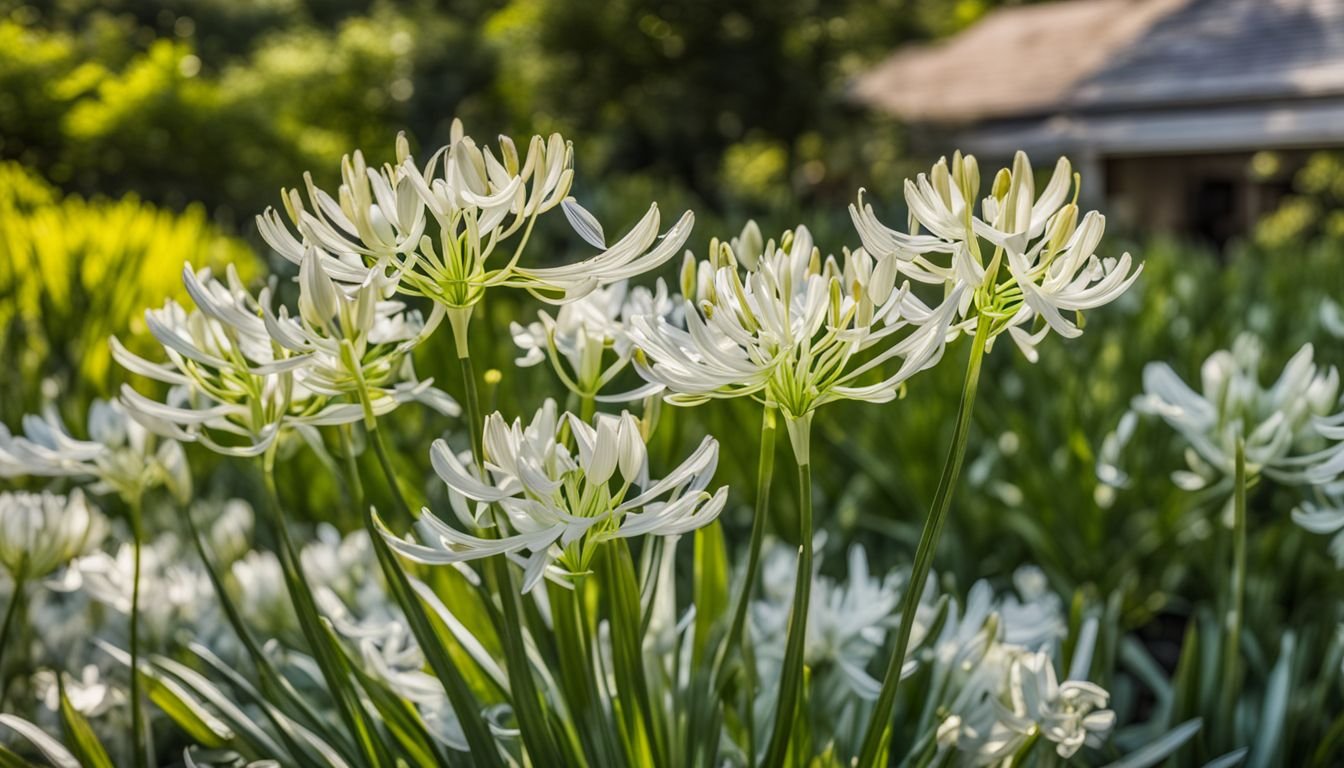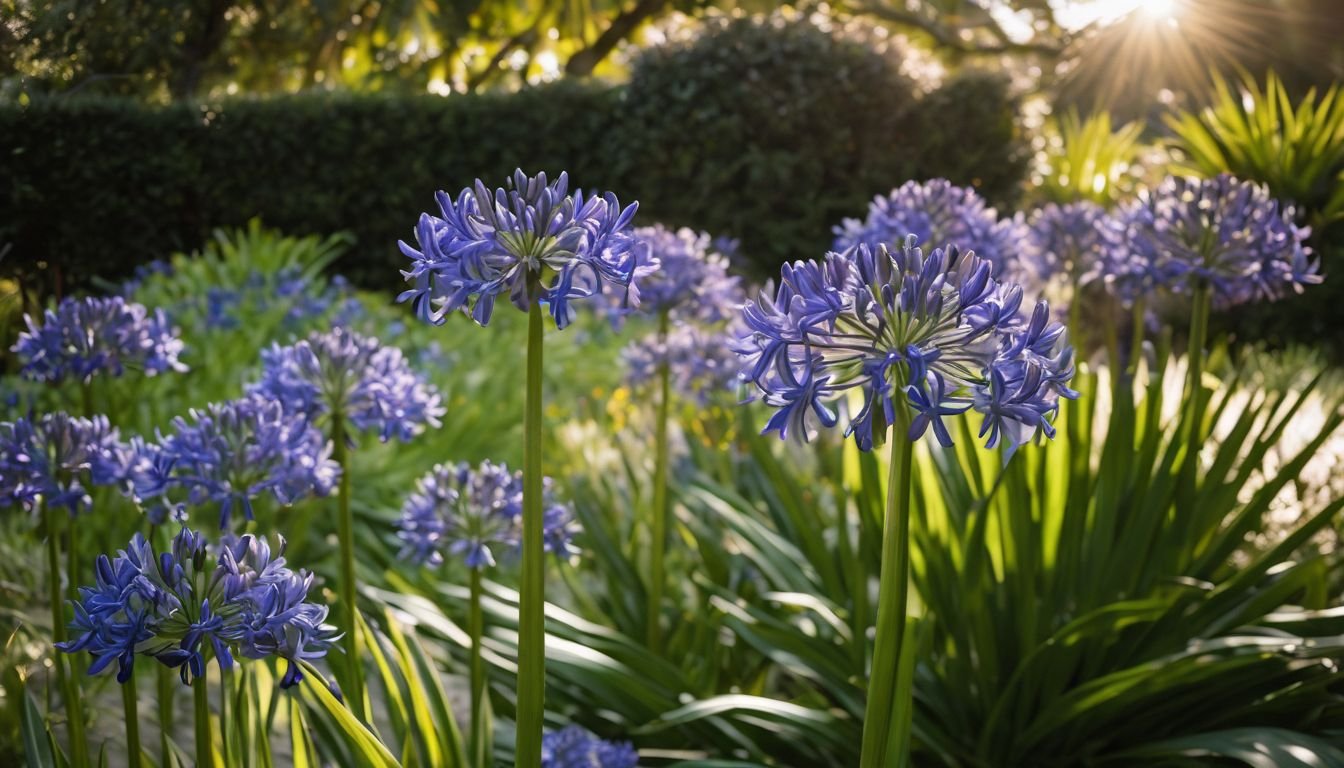When you spot the lush leaves of your agapanthus turning a worrying shade of yellow, it can really throw a spanner in the works for any gardener. This all-too-common issue tends to sneak up on us, sparking a bit of a scramble to find remedies.
But here’s a bit of good news: You’re certainly not battling this alone. Many of us have watched, with a fair bit of disappointment, as our cherished plants started looking less than chipper.
Quite often, it turns out that an iron deficiency is at the heart of this pesky yellowing.
After doing some serious digging and having yarns with several gardening gurus, we’ve managed to put together quite the comprehensive guide for taking this problem head-on. Our advice covers everything from understanding why your agapanthus might be feeling off colour to implementing straightforward solutions—so you can rest easy knowing we’ve got your back.
Let’s dive in and help those greens regain their vibrancy!
Key Takeaways
- Check your agapanthus plants regularly for pests like mealybugs, red spider mites, and fungus gnat larvae. Catching these bugs early can stop them from turning the leaves yellow.
- Make sure to water your agapanthus correctly. They don’t like too much water. The soil should be moist but not soaked to avoid root rot and keep the leaves green.
- Iron deficiency often causes yellow leaves in agapanthus plants. Test your soil’s pH level and use iron supplements if needed to fix this problem and boost plant health.
- Protect your agapanthus from too much direct sunlight which can lead to sunburned leaves. A little shade during the hottest part of the day helps keep them healthy.
- Applying insecticidal soap directly onto pests and using beneficial nematodes in the soil are effective ways to manage pest issues without harming your plants.
Causes of Agapanthus Leaves Turning Yellow

Discovering your agapanthus leaves turning yellow can be disheartening. We’ve found that this issue often stems from a few key problems affecting their health and vibrancy.
Lack of iron
Iron deficiency can sneak up on your agapanthus, leaving the leaves a telltale yellow. Often, this is due to our soil conditions being too alkaline. We find it critical to test the soil’s pH and strive for a sweet spot near 6.5.
If it measures above 7, that’s our cue to lower it because an alkaline environment hampers iron absorption by plants.
Over-watering exacerbates the issue by washing away vital nutrients from the root zone, iron included. Our approach involves adjusting watering habits and ensuring proper soil drainage to combat this problem effectively.
Deploying these strategies helps keep our agapanthus thriving and prevents yellow leaves caused by a lack of iron.
Moving forward, let’s explore how over-watering or sunburn also contribute to this challenge with agapanthus care.
Over-watering or sunburn
We often find ourselves eager to provide our agapanthus with plenty of water, especially during the hot days. However, over-watering can actually do more harm than good. It washes away essential nutrients like iron from the root zone, leaving our plants struggling and their leaves turning yellow.
To prevent this, we need to ensure that our watering routine matches the agapanthus’s actual needs—their drought-tolerant nature means they thrive with less water than one might think.
Excessive heat and direct sunlight pose another risk, leading to sunburn on the delicate leaves of agapanthus. This stress results in yellowing or even browning of the foliage as it tries to protect itself from damage.
We should aim to find that sweet spot where our plants receive just enough sunlight without getting scorched; sometimes a bit of shade during the hottest part of the day can make all the difference.
Adjustments in how we care for our agapanthus can significantly reduce these issues. Monitoring soil moisture before watering ensures roots are not sitting in excess water which may lead to root rot—a common outcome of over-watering.
For those sunny spots in our gardens where sunburn becomes a problem, consider protective measures such as shade cloth or strategically placed companion planting to shield agapanthus from harsh midday rays.
Pests infestation
Mealybugs and red spider mites are notorious for making agapanthus leaves turn yellow. These pests suck the sap out of the leaves, leaving them weak and discoloured. We’ve noticed that applying insecticidal soap directly to these invaders can stop them in their tracks, helping keep our plants healthy and vibrant.
Fungus gnat larvae also pose a threat as they disrupt moisture flow within the plant, which contributes to yellowing leaves. Managing moisture levels in soils can deter these gnats from laying eggs.
For those already dealing with an infestation, introducing bacillus thuringiensis into the soil has proven effective in targeting gnat larvae without harming the plants. Regular monitoring for black rot and treating at early signs can prevent further damage to your beloved agapanthus.
Fungal diseases
Moving from pests, we also need to tackle another significant threat to our agapanthus – fungal diseases. These cunning invaders can cause yellow or brown spots on the leaves, a clear sign of trouble beneath the surface.
Anthracnose stands out as a notorious fungus responsible for such damage. But fear not! With proper plant debris management and strategic watering techniques, we can keep these pesky fungi at bay.
Effective prevention hinges on routine mulching and prudent pruning too. We ensure our plants are not just drought tolerant but also resistant to the stealthy advances of fungal foes by creating an environment that discourages their growth.
It’s all about maintaining the health and beauty of our agapanthus, safeguarding them against potential outbreaks that could mar their vibrant foliage.
Tips to Prevent Yellowing of Agapanthus Leaves

We’ll show you how to keep your agapanthus thriving, with smart strategies tailored for Australian gardens.
Regular monitoring for pests and diseases
Our gardens are homes to our beloved plants, including the agapanthus. To keep their leaves vibrant and healthy, we must stay vigilant against pests and diseases that can cause harm.
Mealybugs, red spider mites, and fungus gnat larvae are known culprits for turning those lush green leaves yellow. Spotting these invaders early makes all the difference.
Checking our plants regularly helps us catch signs of trouble before they escalate. Diseases such as anthracnose and bulb rot also threaten agapanthus by leading to yellowing leaves if not addressed promptly.
Using a magnifying glass might help in identifying smaller pests or the early stages of disease which could save your plant in the long run.
Implementing preventive measures like cleaning debris around plants reduces the risk of fungal diseases while encouraging beneficial insects can naturally control pest populations.
Let’s make regular inspections a part of our gardening routine to protect our agapanthus from these unwanted visitors.
Proper watering techniques
We always make sure to water our agapanthus plants correctly, as this is crucial in preventing their leaves from turning yellow. It’s important to avoid over-watering and ensure the soil has proper drainage.
We aim for a balance, keeping the soil moist but not soggy. This prevents root rot and supports healthy growth.
Our watering routine changes with the seasons, giving more water during dry spells and reducing it when we get ample rain. Monitoring soil moisture helps us decide when to water next.
Watering in the morning allows foliage time to dry before nightfall, minimising disease risk. Next up, let’s talk about ensuring your agapanthus gets enough iron for optimal health.
Ensuring sufficient iron supply
Ensuring our agapanthus plants receive enough iron is crucial to prevent their leaves from turning yellow. Iron deficiency often manifests as yellowing leaves, a problem we can’t ignore.
Testing the soil’s pH levels and adjusting them if necessary helps maintain an environment where iron doesn’t easily leach away, especially in heavy watering conditions.
Applying iron supplements directly to the soil around our plants offers a quick fix to this issue. It’s important we choose the right product and follow the instructions carefully to avoid over-application, which could harm more than help.
Regularly checking our agapanthus for signs of yellowing enables us to act swiftly, ensuring they continue thriving in Australian gardens.
How to Treat Yellowing Agapanthus Leaves
We’ve discovered effective methods to bring back the lush green look of your Agapanthus plants. Applying iron supplements directly to the soil around your plants can significantly improve their health and appearance.
Using iron supplements
We often find that our agapanthus leaves start showing signs of yellowing, and one common culprit behind this troubling symptom is a lack of iron. To combat this, we turn to iron supplements, an effective solution for reversing the deficiency causing the discolouration.
Implementing these supplements into our gardening routine can significantly improve the health and appearance of our plants.
To ensure optimal absorption by our agapanthus, we first test the soil’s pH level. If it reads higher than 7, we take steps to lower it to around 6.5. This adjustment makes it easier for the plant to absorb iron effectively from the soil or added supplements.
Iron supplements are readily available in various forms such as granules or liquid feeds, making application straightforward and accessible.
Next up, let’s explore how implementing pest control measures can further enhance the vitality of our agapanthus plants.
Implementing pest control measures
Our gardens face various challenges, and keeping pests at bay is crucial for healthy agapanthus plants. Applying insecticidal soap can effectively tackle mealybugs, red spider mites, and fungus gnat larvae threatening our beloved blooms.
It’s essential to follow the product instructions carefully to ensure we target the pests without harming our plants.
Introducing beneficial nematodes into our garden soil offers another layer of protection by naturally controlling pest populations. They attack soil-dwelling larvae, reducing future infestations and helping preserve the health of our agapanthus.
This approach aligns with our commitment to eco-friendly gardening practices, ensuring a safe environment for both plants and pollinators.
Adjusting watering routines
We’ve found that tweaking our watering routines can make a huge difference in preventing yellow leaves on agapanthus. Over-watering is often the culprit behind this common issue, leading to bulb rot and making the plant more susceptible to diseases like Anthracnose.
This fungal disease thrives in moist environments, creating unsightly yellow or brown spots across the foliage. To combat this, we ensure our plants receive just enough water without drowning them, checking the soil’s moisture level before deciding to water again.
Inspecting and potentially replanting agapanthus in fresh soil plays a pivotal role in adjusting our watering habits effectively. It allows us to start afresh, ensuring that both soil pH levels and drainage are optimal for healthy growth.
By maintaining soil pH around 6.5, we prevent iron from leaching out of the root zone – an essential step towards keeping those leaves green and vibrant. As we move forward with these adjustments, let’s explore how ensuring a sufficient iron supply further aids in keeping agapanthus foliage lush and healthy.
Conclusion
Keeping your agapanthus glowing with health is within reach. Regular checks for pests and knowing the right amount of water and sun can make all the difference. Remember, a bit of iron now and then doesn’t hurt either.
Your garden will thank you with vibrant, green leaves that stand out beautifully. Let’s keep our agapanthus thriving, Australia!
Explore More on Agapanthus Care [Link to https://gardenplantjoy. com. au/blogs/plants]
We’ve tackled the challenge of yellowing agapanthus leaves and shared our insights on prevention and treatment. For those who are keen to dive deeper into agapanthus care, we invite you to explore further at Garden Plant Joy.
Their collection offers a wealth of knowledge tailored specifically for gardening enthusiasts in Australia.
Their articles cover everything from battling leaf spot to ensuring your agapanthus thrive in every season. You’ll find practical tips that go beyond the basics, helping you nurture your garden with confidence.
Whether it’s fighting off pests or mastering watering techniques, their guides are an invaluable resource for anyone looking to boost their green thumb prowess.
FAQs
1. Why do Agapanthus leaves turn yellow?
Agapanthus leaves can turn yellow due to overwatering, poor drainage, or lack of nutrients in the soil.
2. How can I improve the soil for my Agapanthus?
You can improve the soil by adding compost or a well-balanced fertiliser to provide essential nutrients.
3. Is too much sun bad for Agapanthus plants?
Yes, while Agapanthus enjoys sunlight, excessive direct sun can harm its leaves and lead to yellowing.
4. Can underwatering cause Agapanthus leaves to go yellow?
Underwatering your Agapanthus plants can also lead to yellowing leaves due to stress from lack of moisture.
5. Should I remove yellow leaves from my Agapanthus plant?
Removing yellowed or dead leaves helps maintain healthy growth and appearance of your Agapanthus plant.
